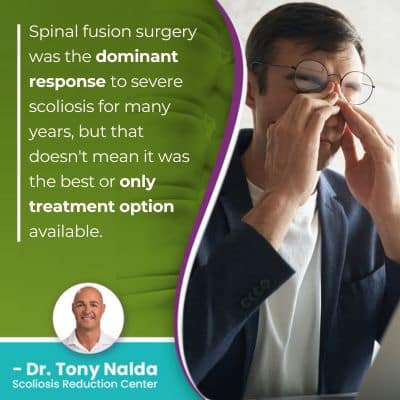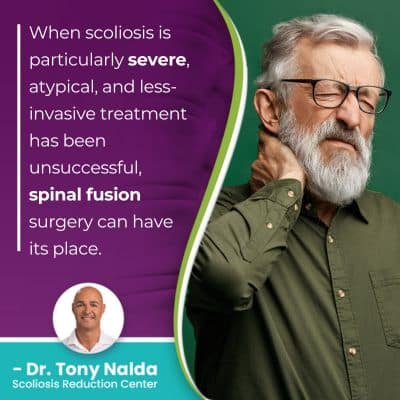When Is Spinal Fusion Necessary? Signs to Look For!

Spinal surgery is invasive, and spinal fusion is a costly and risky procedure that isn't always necessary; it should be considered only after less-invasive forms of treatment have been unsuccessful. A common long-term effect of spinal fusion is a noticeable loss in spinal flexibility and range of motion.
While there is both a surgical and nonsurgical treatment response to scoliosis, most patients don't need surgery, particularly when diagnosed early and treated proactively. Spinal fusion can be necessary when scoliosis is particularly severe, atypical, or has been left untreated.
It's more beneficial to know the early signs of scoliosis to look for because this can lead to early detection and avoiding the need for surgical treatment in the future.
Table of Contents
Early Detection and Intervention
No two cases of scoliosis are the same, and while there are never treatment guarantees, with early detection, conditions are diagnosed while they are at their mildest; as a progressive condition, the nature of scoliosis is to get worse over time.
Scoliosis involves the development of an unnatural sideways-bending and rotating spinal curve, and progression means the size of the curve will increase, as will the condition's uneven forces, and their effects.
Smaller scoliotic curves are simpler to treat, and as progression occurs, the spine gets increasingly rigid and less responsive to treatment; in addition, increasing spinal rigidity can also make it difficult for some patients to perform key therapeutic exercises as part of treatment.
Condition effects increase alongside progression, making the condition more noticeable, so it's not uncommon for some patients to be diagnosed after years of living with the condition unaware, and this is also why a patient's diagnosis doesn't always align with the condition's onset.
In most cases, it's more effective to proactively work towards preventing progression and increasing condition effects than it is to attempt to reverse effects once they're established: the benefit of early detection.
However, the benefits of early detection are only available to those who respond to an early diagnosis with proactive treatment.
Being Proactive with Scoliosis Treatment
 Being proactive with scoliosis treatment doesn't just mean starting it as close to the time of diagnosis as possible, it means the approach focuses on preventing progression, rather than reacting to it, and this is a key difference between traditional and conservative scoliosis treatment.
Being proactive with scoliosis treatment doesn't just mean starting it as close to the time of diagnosis as possible, it means the approach focuses on preventing progression, rather than reacting to it, and this is a key difference between traditional and conservative scoliosis treatment.
Traditional scoliosis treatment doesn't have a strategy for addressing scoliosis while mild, so a diagnosis of mild scoliosis is often met with the recommendation to watch and wait for signs of continued progression.
Traditional scoliosis bracing is commonly prescribed for moderate scoliosis patients, but nothing is done beforehand to prevent mild scoliosis from becoming moderate, and if/when moderate scoliosis progresses and becomes severe, patients are funneled towards spinal fusion surgery.
In modern conservative treatment, an early diagnosis of mild scoliosis is met with a customized treatment plan started immediately following the diagnosis; this is when conditions are going to be at their mildest and most treatable.
Scoliosis progressing means its effects are getting more overt, and in children, the main effects involve postural changes such as uneven shoulders and hips, and in adults, the main effect is pain; scoliosis doesn't become a compressive condition until skeletal maturity has been reached.
Compression of the spine and its surrounding muscles and nerves is the main cause of condition-related pain.
So being proactive with treatment means working towards impacting conditions on multiple levels so progression can be prevented, along with increasing condition effects; while scoliosis is progressive and incurable, it can be highly treatable, particularly with early detection and intervention.
What is Spinal Fusion?
Spinal fusion surgery was the dominant response to severe scoliosis for many years, but that doesn't mean it was the best or only treatment option available.
There are different types of spinal fusion, but most involve fusing the curve's most tilted vertebrae together into one solid bone and removing intervertebral discs that sit between adjacent vertebrae to be fused.
Rods are then attached to the spine so it is held in a straighter alignment, but fusing the spine in this manner is contrary to the spine's natural movement-based design.
All surgical procedures come with their share of risks, and spinal fusion is no exception; the procedure itself is associated with a number of risks:
- Infection
- Nerve damage
- Excessive blood loss
- Adverse reaction to hardware used
What most concerns me, however, are the long-term effects of spinal health and function that spinal fusion can be associated with.
Fusing vertebrae is done to eliminate movement in the area; this means the vertebrae can't become more tilted over time (progression), but this can come at the cost of the spine's overall flexibility and range of motion.
While some patients maintain enough spinal flexibility above and below the fused portion, many experience a noticeable loss that can be disruptive to a patient's quality of life, and in addition, fused spines are weaker and more vulnerable to injury.
So spinal fusion is performed as part of a traditional scoliosis treatment approach when conditions are severe, but are there other times when spinal fusion is necessary?
When is Spinal Fusion Necessary?
When scoliosis is particularly severe, atypical, and less-invasive treatment has been unsuccessful, spinal fusion surgery can have its place.
When spinal fusion can also be necessary is in atypical types of scoliosis; most scoliosis patients, approximately 80 percent, are diagnosed with idiopathic scoliosis, meaning cause unknown, and the remaining 20 percent consist of types with known causes.
Neuromuscular scoliosis, degenerative scoliosis, and congenital scoliosis are considered atypical and can have left-bending curves that bend towards the heart, when typical cases of idiopathic scoliosis involves curves that bend to the right, away from the heart.
 When I see a left-bending curve, I know there is an underlying pathology causing the development of scoliosis that complicates the treatment process and can make cases particularly severe.
When I see a left-bending curve, I know there is an underlying pathology causing the development of scoliosis that complicates the treatment process and can make cases particularly severe.
Neuromuscular scoliosis, for example, is caused by the presence of a larger neuromuscular condition like spina bifida, cerebral palsy, or muscular dystrophy.
While not everyone with a neuromuscular condition will develop scoliosis, it is a common complication, and because the scoliosis develops as a secondary complication of a larger issue, the treatment process is complicated, and these cases are considered atypical.
Neuromuscular conditions cause a disconnect between the brain, the spine, and the muscles and connective tissues that support the spine, so the scoliosis tends to be severe, curves are more rigid, and many patients becomes wheelchair bound and unable to move on their own; sometimes, these types of severe and atypical cases can benefit from surgical treatment.
For typical cases of idiopathic scoliosis, however, there is conservative nonsurgical treatment with proven results.
The Benefits of Nonsurgical Treatment
The benefit of nonsurgical treatment is that it's integrative, customized, effective, and it can spare patients the hardships associated with invasive spinal surgery, recovery, and life with a fused spine.
Spinal fusion surgery involves fusing the curve's most-tilted vertebrae at its apex into one solid bone and removing discs in between, and while this can stop those vertebral bodies from becoming more tilted, bone healing can take time, and when two or more vertebrae are fused, there can be a disruptive loss in spinal flexibility as a result.
Spines that are fused are also weaker and more easily injured, causing hesitancy in participating in once-loved activities.
Nonsurgical scoliosis treatment works by integrating multiple scoliosis-specific treatment disciplines into treatment plans so conditions are impacted on every level, and as treatment is applied as early in a condition's progressive line as possible, there are fewer limits to what can be achieved.
Conservative nonsurgical treatment combines chiropractic care, physical therapy, corrective bracing, and rehabilitation, and these facets of treatment are natural and noninvasive so they work while persevering as much of the spine's natural strength and function as possible.
A fused spine is fused for life; there is no recourse if a fusion fails other than more surgery.
Conclusion
While spinal fusion still has a place in the treatment of scoliosis when cases are particularly severe, atypical, and/or have been left untreated, conservative treatment provides a less-invasive nonsurgical treatment alternative.
When typical cases of idiopathic scoliosis are diagnosed early and responded to with proactive conservative treatment, progression can be prevented and corrective results can be achieved.
Corrective results mean the size of the unnatural spinal curve has been reduced structurally, and core strength has been increased so the spine is being optimally supported and stabilized by its surrounding muscles.
Corrective bracing can be particularly effective on growing spines so is a regular facet of treatment for childhood scoliosis, and the ultra-corrective ScoliBrace can augment corrective treatment results by pushing the spine into a corrective position.
Here at the Scoliosis Reduction Center, being proactive and applying a customized conservative treatment plan as close to the time of diagnosis as possible helps avoid possible complications and the need for invasive spine surgery in the future.
Dr. Tony Nalda
DOCTOR OF CHIROPRACTIC
After receiving an undergraduate degree in psychology and his Doctorate of Chiropractic from Life University, Dr. Nalda settled in Celebration, Florida and proceeded to build one of Central Florida’s most successful chiropractic clinics.
His experience with patients suffering from scoliosis, and the confusion and frustration they faced, led him to seek a specialty in scoliosis care. In 2006 he completed his Intensive Care Certification from CLEAR Institute, a leading scoliosis educational and certification center.
About Dr. Tony Nalda
 Ready to explore scoliosis treatment? Contact Us Now
Ready to explore scoliosis treatment? Contact Us Now





